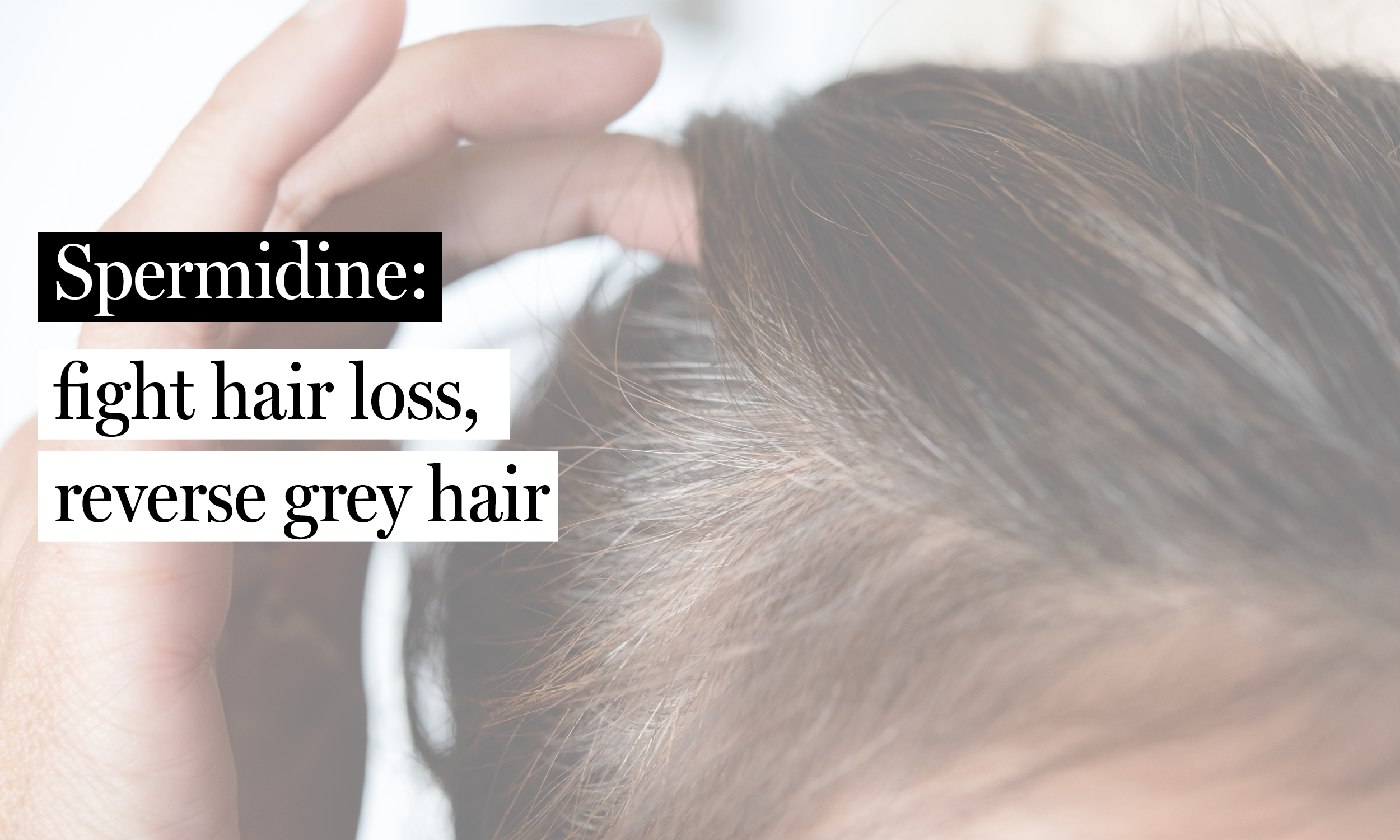
Grey hair and hair thinning/loss are often the first visible signs of aging, marking the inevitable passage of time. For many, these changes serve as a subtle reminder that our bodies are evolving. While some embrace this natural shift, others seek ways to maintain a youthful appearance. But have you ever wondered why we lose hair and why it turns grey? It all comes down to a disruption in the normal hair growth cycle and a decrease in melanin, the pigment responsible for the color of our hair, skin, and eyes. Recent findings have unveiled a connection between spermidine and the slowing of the aging process, including hair shedding and graying. Research indicates that spermidine could be a promising compound for improving hair health, including the prevention or treatment of grey hair, by enhancing melanin production and maintaining hair follicle function.
The hair growth cycle: understanding its phases and how aging affects it
The hair growth cycle consists of three phases: anagen, catagen, and telogen, each playing a vital role in the life of a hair strand. Understanding these phases is important for exploring the effect of spermidine on hair growth.
- The anagen phase is the active growth stage of the hair cycle, where hair follicles rapidly produce new cells, leading to hair lengthening. Hair grows about 1 cm per month during this phase, which lasts between 2 to 7 years depending on genetics, age, and health. The length of this phase determines how long your hair can grow, making it crucial for achieving healthy, long hair. As we age, the duration of the anagen phase can shorten, resulting in less hair growth.
- The catagen phase is a short transitional period lasting about 2 to 4 weeks. During this stage, hair growth stops as the follicle detaches from its blood supply and ceases cell production. A "club hair" forms at the base, anchoring the strand to the follicle. Although growth has stopped, the hair remains in place until the next stage. Aging can affect the efficiency of this transition, potentially leading to hair thinning.
- The telogen phase is the final stage of the cycle, where the follicle rests and prepares to restart. This phase lasts about three months, during which old hair is naturally shed to make way for new growth. On a healthy scalp, approximately 100 hairs are shed daily, and 10-15% of the hair is in this phase at any given time. With age, more hair follicles may enter this phase simultaneously, leading to increased hair shedding. After shedding, the follicle re-enters the anagen phase, beginning the cycle anew.
The hair growth cycle ensures continuous renewal of your hair. Although follicles are not all in the same phase simultaneously, maintaining a balance between these stages is essential for a healthy head of hair. When everything functions normally, the telogen phase transitions smoothly into the anagen phase, supporting ongoing hair growth.
As we age, the hair growth cycle can become less efficient. The anagen (growth) phase shortens, while the telogen (resting) phase lengthens, leading to slower hair growth and more hair follicles remaining in the shedding phase for longer periods. This results in thinner hair and potentially more noticeable hair loss. Hormonal shifts, such as reduced estrogen or increased sensitivity to dihydrotestosterone, contribute to follicle shrinkage and thinning, particularly in men and postmenopausal women. Reduced blood flow, oxidative stress, and stem cell aging further weaken follicles, while genetic predisposition and lifestyle factors like stress and poor nutrition accelerate the process. Additionally, the reduced production of melanin contributes to hair turning grey or white.
How spermidine supports hair growth
Spermidine has been identified as a potent stimulator of human hair growth and a novel modulator of human epithelial stem cell functions. In vitro studies demonstrate that spermidine promotes hair shaft elongation and prolongs the anagen phase of hair follicles. It achieves this by upregulating the expression of epithelial stem cell-associated keratins K15 and K19, which are crucial for hair follicle health and growth. Additionally, spermidine modulates key genes involved in cell adherence, migration, and mitochondrial functions, indicating its broad impact on cellular processes.

Spermidine supports hair growth. Spermidine stimulates autophagy, promotes mitochondrial function and the production of keratins in epithelial stem cells, leading to the regeneration of hair follicle. Adapted from Madeo et al., 2018. © 2025 Melissa Cano. All rights reserved.![]()
Clinical evidence supports these findings, as a randomized, placebo-controlled, double-blind study demonstrated that a spermidine-based nutritional supplement increased the number of anagen V-VI hair follicles after three months of treatment. This was accompanied by increased levels of Ki-67, a marker for cellular proliferation, and decreased levels of c-Kit, a marker for apoptosis, suggesting enhanced hair follicle health and reduced cell death. Furthermore, the pull test results indicated that the spermidine supplement helped maintain hair growth, with significantly fewer subjects experiencing hair loss compared to the placebo group.
The importance of autophagy in hair growth
Autophagy and mitophagy have emerged as essential processes for maintaining hair follicle health and function. Autophagy, the degradation and recycling of cellular components, and mitophagy, the selective elimination of damaged mitochondria, ensure cellular homeostasis within hair follicles. Research shows that dysfunction in these processes has been linked to various hair loss conditions, including androgenetic alopecia (most prevalent form of hair loss with gradual thinning) and alopecia areata (consequence of an autoimmune disorder). A 2019 study in Cell demonstrated that autophagy induction is both necessary and sufficient for initiating the anagen phase, the active growth stage of hair follicles. Autophagy is elevated during the anagen (growth) phase of the hair follicle cycle, decreases in the catagen (regression) phase, and remains low in the telogen (resting) phase. This pattern suggests that proper autophagic activity is crucial for hair follicle stem cell activation and hair growth. Compounds like rapamycin, metformin, and α-ketoglutarate were shown to stimulate autophagy, thereby activating dormant (telogen) hair follicles and promoting new hair growth. Additionally, aged mice consuming autophagy-inducing metabolites, such as α-ketobutyrate, exhibited protection against hair loss, underscoring autophagy's role in sustaining hair growth over time. While spermidine was not directly examined in this study, previous research has unambiguously identified it as a potent and safe autophagy and mitophagy inducer. Therefore, these findings also support the potential of spermidine as an autophagy activator to enhance hair growth.

Spermidine stimulates autophagy and the anagen phase of the hair follicle. Autophagy is elevated during the anagen (growth) phase of the hair follicle cycle, decreases in the catagen (regression) phase, and remains low in the telogen (resting) phase. The overall balance of these phases becomes disrupted with age, contributing to the thinning, loss, and graying of hair. Supplementing with spermidine helps increase autophagy levels in hair follicles and stimulate hair growth. © 2025 Melissa Cano. All rights reserved.
How spermidine may support grey hair reversal
A recent study published in Scientific Reports suggests that spermidine may be a promising treatment for premature hair graying. The study found that spermidine increases melanin production by stabilizing melanogenesis-associated proteins, specifically tyrosinase-related proteins 1 and 2 (TRP-1 and TRP-2), without altering the expression of related genes. This stabilization reduces protein degradation, potentially restoring pigmentation in hair. Given that spermidine levels decline with age, supplementation could help maintain optimal polyamine levels, thereby addressing premature hair graying and other hypopigmentation disorders.
In summary, spermidine promotes hair growth by prolonging the anagen phase, stimulating hair follicle stem cell functions, and inducing autophagy and may be a powerful ally to reverse hair graying by increasing melanin production. These findings suggest that supplementing with spermidine could serve as a therapeutic agent for treating hair loss and bringing back your natural color!







